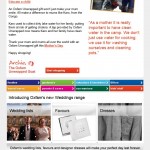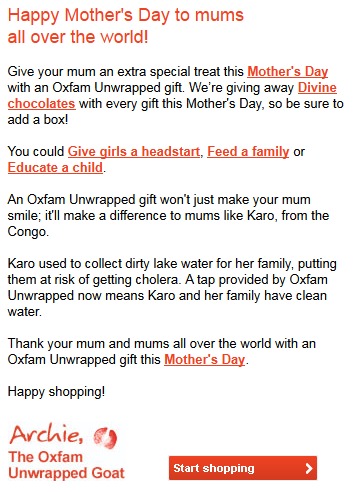As an email ninja I get very few email newsletters that I’m not interested in or don’t read so it was interesting to see how many people on my course have written about emails that they don’t open. I decided to write about one of the emails I pretty much always open so I could be all gushing and nice rather than shouting at some poor email marketer who dared send me an email I opted in for.
 I chose an email that had worked on me, the latest one from Oxfam, one of my favourite charities. I always read their emails as they contain a mix of campaigning actions, product information and updates on their progress. I receive emails from Oxfam as I’ve ordered gifts from them in the past and have clicked through from prior emails about their campaigns.
I chose an email that had worked on me, the latest one from Oxfam, one of my favourite charities. I always read their emails as they contain a mix of campaigning actions, product information and updates on their progress. I receive emails from Oxfam as I’ve ordered gifts from them in the past and have clicked through from prior emails about their campaigns.
This email (pictured left, click to view the full size version) promotes their Oxfam Unwrapped range of gifts as ideal Mother’s Day presents.
The header comprises three links which relate to the three themes of the message; Mother’s Day, the special offer of free chocolates with every order and the weddings range which forms the second half of the email body. This helps people who read their emails in a preview pane (where only the start of the message is visible) as well as opening the message with key messages to encourage people to keep reading.
 The main body of the email combines several short paragraphs of text, a photo and a testimonial quote which appears to be from a prior recipient of Oxfam support. The text is full of links (six in total) to various sections of the Oxfam Unwrapped site; a special offer landing page (used three times) and three individual product links that are based around families and women. The section ends with a ‘start shopping’ call to action to emphasise the point.
The main body of the email combines several short paragraphs of text, a photo and a testimonial quote which appears to be from a prior recipient of Oxfam support. The text is full of links (six in total) to various sections of the Oxfam Unwrapped site; a special offer landing page (used three times) and three individual product links that are based around families and women. The section ends with a ‘start shopping’ call to action to emphasise the point.
The text moves from referencing your mum (not in a ‘your mum’ joke sort of way I hasten to add!) to mothers who have benefitted from Oxfam Unwrapped before tying the concepts together with ‘Thank your mum and mums all over the world with an Oxfam Unwrapped gift this Mother’s Day’ using empathy to reinforce the call to action.
The quote and photo aim to give a human touch to the story. The use of an individual quote rather than statistics about the scope of problems such as dirty water reminded me of this recent Guardian article about how people find it easier to relate to individual stories rather than broad statistics.
The email is then divided with eight colourful boxes linking to other gift categories, this is quite a good discreet way of reminding readers of the breadth of gifts available as well as potentially prompting sales unrelated to the Mother’s Day theme.
![]()
The second section of the email introduces a new range from Oxfam with three images linking to the relevant sections of Oxfam’s site. There is no call to action in this section, maybe because weddings are more of a niche market.
The email ends with a three updates from Oxfam on different topics; fundraising opportunities, gift ideas and campaigning. This is a great way of illustrating the range of Oxfam’s activities and definitely something charities and commercial organisations could use. The footer contains links to Oxfam’s website and social media channels as well as unsubscription information, contact details and legal information about the sender.
I like the layout of the message as it is simple but interesting as it features a variety of topics and colours without being overwhelming.
The special offer’s landing page reiterates the free chocolates offer then lists some of their bestsellers. This acts as an endorsement from other customers and encourages confidence in the product and organisation. The page lists as three-step process to complete the purchase which presumably helps convert potential buyers.
The email doesn’t contain any personalisation though it would be interesting to know whether this email was targeted in any way based on the demographic or interaction history Oxfam know about me. It is unclear whether the campaigning, fundraising and sales messages I receive from Oxfam are connected at all. It would be interesting to know whether targeted or personalised emails, ‘you signed our petition about X so you might want to donate Y’, would lead to more sales or donations. As Oxfam work in so many countries, across so many projects and in different ways I wonder if and how they segment their subscribers and supporters at all.
P.S. Mum, if you’re reading this, act surprised on Mother’s Day!
